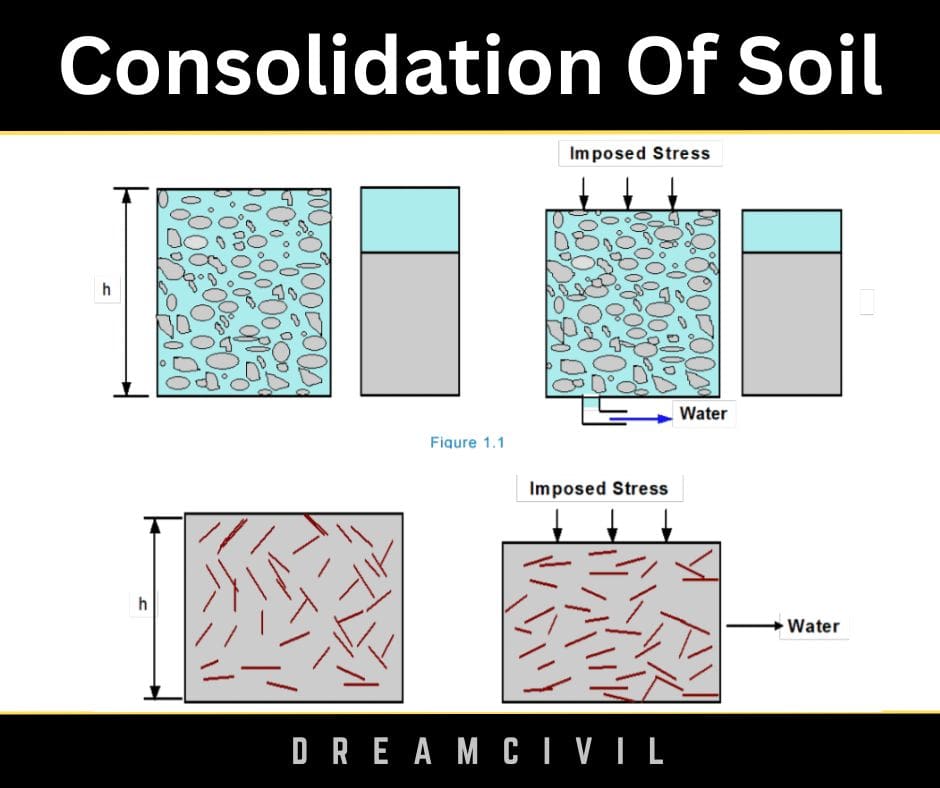Table of Contents
The compression of saturated soil under steady static pressure is known as consolidation of Soil.
The compressibility of soil is defined as the capability of the soil to decrease its volume under mechanical loads.
In contrast, soil consolidation is the compression of saturated soil under steady pressure, and it occurs due to water expulsion from the soil voids. Compressibility and consolidation of soil are essential parameters needed in the design considerations.
The soil consolidation is categorized into three stages: initial, primary, and secondary. The soil consolidation is time-dependent, and its analysis is founded on Terzaghi’s theory.
It is fundamental to understand the rate of consolidation and the total consolidation to be desired for the design of structures. In this way, the designer could set necessary precautions and design considerations to keep the settlement to a tolerable limit. Otherwise, the desire to use the structure may be impaired, and the structure’s design life may be reduced.
1. Compressibility of Soil
When a soil mass is put through a compressive force, its volume declines, i.e., the settlement quantity. The property of the soil due to which a reduction in volume arises under compressive force is known as the compressibility of soil.
The compression of soil can occur due to the compression of solid particles and water in the voids, compression and expulsion of air in the voids, and expulsion of water in the voids.

2. Consolidation of Soil
The compression of saturated soil under steady static pressure is known as consolidation, entirely due to water expulsion from the voids. Consolidation is commonly associated with fine-grained soils such as silts and clays.
Coarse-grained soils, such as sands and gravels, also undergo consolidation but much quicker due to their high permeability. Saturated clays shrink gradually due to their lower permeability.
The process of compaction usually complicates the process of consolidation. Compaction raises the density of unsaturated soil by decreasing the air volume in the voids. However, consolidation is a time-related process of raising the density of saturated soil by draining some of the water out of the voids.
Consolidation theory is needed to predict both the magnitude and the rate of consolidation settlements to ensure the serviceability of structures based on a compressible soil layer.

3. Components of Consolidation
Consolidation of soil is made of three components which contain initial consolidation, primary consolidation, and secondary consolidation:
1. Initial Consolidation
When a force is applied to partially saturated soil, the volume of the soil will reduce because the air in the empty spaces is compressed and discharged. Further, a slight volume reduction will be due to the solid particle’s compression.
After involving pressure to the soil, the resulting reduction in volume is referred to as initial consolidation or initial compression. This process is mainly generated by the compression of solid particles in saturated soils.

2. Primary Consolidation
After initial consolidation, a further decrease in volume happens because of the expulsion of water from the voids.
When saturated soil is subjected to pressure, initially, all the involved pressure is taken up by water as a surplus pore water pressure.
A hydraulic gradient would evolve, the water begins flowing out, and a reduction in volume emerges.
This compaction in volume is called the primary consolidation of soil. In fine-grain soils, the primary consolidation happens over a long time. However, in coarse-grained soils, the primary consolidation happens fastly because of high permeability.
3. Secondary Consolidation
The reduction in volume continues at a prolonged rate even after the excess hydrostatic pressure developed by the applied pressure is entirely dissipated and the primary consolidation is complete.
The further decrease in the volume is called secondary consolidation. Secondary consolidation evolves essential for specific soil types, such as peats and soft organic clays.
5. References1. Content Filter & Authenticity Checking Team, Dream Civil International (Our team checks every content & detail to maintain quality.) |
Read Also: Bathroom Renovation

